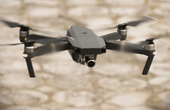Falcon 8+ drone
The Intel Falcon 8+ drone is designed to provide consistent, stable flights in the face of external influences like weak GPS signals and high winds as well as providing resistance to magnetic field disturbances. The Intel Falcon 8+ is for a light-weight drone for professional use. The drone has a patented V-form octocopter which provides a full electronic system redundancy, which features redundant batteries, redundant communication between all flight relevant components and redundant sensing. The unique, patented V-shaped design helps ensure unobstructed data capture and enables a greater than 180 degree view from top to bottom for a range of perspectives, from one camera, in one flight.
Technical Specifications
| Length | 768 |
| Width | 817 |
| Height | 160 |
| Empty weight | 1.2 |
| Payload weight (camera and gimbal) | 0.8 |
| Number of rotors | 8 |
| Rotor Diameter | 20.32 |
| Flight time | 16-26 |
| Max data link range | 1 |
| Max altitude | 4000 |
| Max video link range | 500 |
| Max tolerable wind speed | 12 |
| Power supply | 2 |
| Operating temperature | -5 °C to 40 |
| Navigation sensors | |
| AscTec Trinity Control Unit | |
| Global Navigation Satellite System (GNSS) | |
| Max airspeed | |
| Manual Mode | 18 |
| Height Mode | 18 |
| GPS Mode | 4.5 |
| Wireless communication | |
| Two independent (diversity) command and control li | 2.4 |
| Digital video link | |
Overview
The Intel Falcon 8+ drone is designed to provide consistent, stable flights in the face of external influences like weak GPS signals and high winds as well as providing resistance to magnetic field disturbances.
The Intel Falcon 8+ is for a light-weight drone for professional use. The drone has a patented V-form octocopter which provides a full electronic system redundancy, which features redundant batteries, redundant communication between all flight relevant components and redundant sensing. The unique, patented V-shaped design helps ensure unobstructed data capture and enables a greater than 180 degree view from top to bottom for a range of perspectives, from one camera, in one flight.
The UAS has automated aerial sensing solutions with onboard sensors – providing detailed orthography down to millimeter accuracy Ground Sample Distance (GSD). Consistent waypoint automation enables exactly reproducible flights for valuable structural analysis.
A triple redundant autopilot with three redundant inertial measurement units compensates for hardware failures, external influences like electromagnetic fields and hard winds.
The drone is controlled via the Intel Cockpit, a control system featuring a water resistant, robust user interface for use in harsh outdoor environments.

The cockpit has an integrated tablet, enabling operators to plan and execute complex missions. The Intel Cockpit integrates independent control and safety features with low latency digital video link. This supports payloads with up to 1080p resolutions and live view. The controls the UAS with a single hand flight control joystick.
Intel Powerpack batteries power the Intel Falcon 8+ and the Intel Cockpit. The battery features automatic balancing, storage mode, charging and LEDs that display remaining battery life.
The Falcon 8+ system can be configured as a closed system with isolated, on-board data storage that does not transmit data over the public internet.
References
Describes the product, and has detailed specifications. This page also contains likes to use cases and more video's
More background information about the drone, payload options, flight planning, and ability to contact an Intel drone expert.








